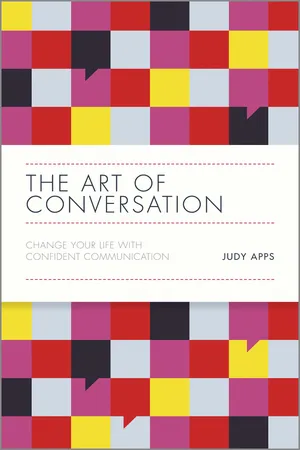
- English
- ePUB (mobile friendly)
- Available on iOS & Android
About This Book
Good conversation is at the heart of networking, meetings, interviews, negotiations and raising your profile. It can ease your way in work, enabling you to build alliances, create strong relationships with staff, bosses and clients, succeed at interviews, motivate and inspire.
But conversation is something most of us were never taught! We learn to speak as babies, but how conversation actually works is something most of us pick up only haphazardly, and many have yet to learn. Why is it some of us are stuck for words, but others blabber or can't stop? What is it that some people have naturally which enables them to converse comfortably and easily, to engage people and build better relationships?
The Art of Conversation will show you step by step how to converse skillfully and enjoyably with other people, at home, at work, on the phone and in the street- even if you're daunted now, discover the difference good conversation can make in every aspect of your life. Learn to:
-Overcome the most common block to good conversation- fear; find out how to break the silence and keep the conversation going
- Understand the different types of conversation and how they work- which topics and language are suitable for the occasion
- Learn simple methods for being heard and understood, including speaking clearly and audibly, listening well and using non-verbal communication
- Find out how to hold a conversation in tricky situations, including how to disagree, how to speak to those in authority and people you find difficult
-Use conversation to form relationships, improve friendships, make the sale, chat people up, to learn, influence and persuade.
Frequently asked questions
Information
Part One
Introducing Conversation
1
The Dance of Conversation

1.1 A Dance for Two

A Subtle Human Art
| ELIZA: | Is something troubling you? |
| ME: | Well, yes it is. |
| ELIZA: | You seem to be quite positive. |
| ME: | Not at all. I've just said something is troubling me. |
| ELIZA: | That's quite interesting. |
| ME: | Well, do you want to hear what it is? |
| ELIZA: | You're not really talking about me – are you? |
| ME: | No, I'm trying to tell you about my troubles if you'll just listen! |
| ELIZA: | Why “no”? |
| ME: | (reacting in frustration, even though I knew it was a machine!) Oh, ... |
Table of contents
- Cover
- Table of Contents
- Endorsements
- Title page
- Copyright page
- Preface
- Acknowledgements
- Introduction
- Part One: Introducing Conversation
- Part Two: The Power of Conversation
- Part Three: Sailing Through Tricky Waters
- Part Four: Creative Conversations
- About the Author
- Image Credits
- Index
- End User License Agreement